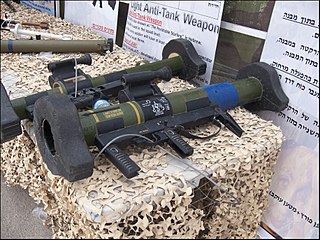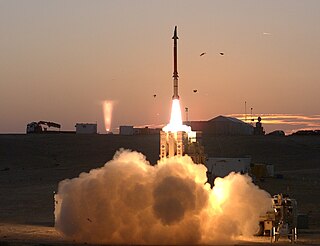Related Research Articles

An unmanned aerial vehicle (UAV), or unmanned aircraft system (UAS), commonly known as a drone, is an aircraft with no human pilot, crew, or passengers onboard. UAVs were originally developed through the twentieth century for military missions too "dull, dirty or dangerous" for humans, and by the twenty-first, they had become essential assets to most militaries. As control technologies improved and costs fell, their use expanded to many non-military applications. These include aerial photography, area coverage, precision agriculture, forest fire monitoring, river monitoring, environmental monitoring, weather observation, policing and surveillance, infrastructure inspections, smuggling, product deliveries, entertainment, and drone racing.

The Rafael Python (פיתון) is a family of air-to-air missiles (AAMs) built by the Israeli weapons manufacturer Rafael Advanced Defense Systems, formerly RAFAEL Armament Development Authority. Originally starting with the Shafrir series, the Shafrir-1 missile was developed in 1959, followed by the Shafrir-2 in early 1970s. Subsequently, the missiles were given the western name of "Python" by the parent company for export purposes, starting with the Python-3 in 1978. Since then, it has been further developed and evolved into the Python-4, Python-5, Derby and also, the SPYDER, an advanced ground-based air-defence system. Currently, the missiles are in service with the armed forces of over fifteen countries from around the world.
Rafael Advanced Defense Systems Ltd. is an Israeli defense technology company. It was founded as Israel's National R&D Defense Laboratory for the development of weapons and military technology within the Israeli Ministry of Defense; in 2002 it was incorporated as a limited company.

The MATADOR is a 90-millimetre (3.5 in) man-portable, disposable anti-armour and anti-brickwall weapon system developed by Germany, Israel and Singapore. It is an updated version of the German Armbrust design, and operates on the same principles. The development of this weapon began in 2000 and the MATADOR will eventually replace the German Armbrust Light Anti-tank Weapon, which has been in service since the 1980s.

Trophy is a protection system for military armored vehicles. It is termed an active protection system (APS) and is designed by Rafael Advanced Defense Systems.

A laser weapon is a type of directed-energy weapon that uses lasers to inflict damage. Whether they will be deployed as practical, high-performance military weapons remains to be seen. One of the major issues with laser weapons is atmospheric thermal blooming, which is still largely unsolved. This issue is exacerbated when there is fog, smoke, dust, rain, snow, smog, foam, or purposely dispersed obscurant chemicals present. In essence, a laser generates a beam of light that requires clear air or a vacuum to operate.

The Hermes 450 is a medium-sized multi-payload unmanned aerial vehicle (UAV) designed by Israeli defence company Elbit for tactical long endurance missions. It has an endurance of over 20 hours, with a primary mission of reconnaissance, surveillance and communications relay. Payload options include electro-optical/infrared sensors, communications and electronic intelligence, synthetic-aperture radar/ground-moving target indication, electronic warfare, and hyperspectral sensors.

The SPYDER is an Israeli short and medium range mobile air defence system developed by Rafael Advanced Defense Systems with assistance from Israel Aerospace Industries (IAI). Rafael is the prime contractor and IAI is the major subcontractor for the SPYDER program. This system achieved a notable milestone in 2005 when missiles were fired against test targets in Shdema, Israel and scored direct hits. Since then, it has been showcased in multiple military exhibitions throughout the world.

Spike is an Israeli fire-and-forget anti-tank guided missile and anti-personnel missile with a tandem-charge high-explosive anti-tank (HEAT) warhead. As of 2024, it is in its sixth generation. It was developed and designed by the Israeli company Rafael Advanced Defense Systems. It is available in man-portable, vehicle-launched, helicopter-launched and maritime variants.

Iron Dome is an Israeli mobile all-weather air defense system, developed by Rafael Advanced Defense Systems and Israel Aerospace Industries. The system is designed to intercept and destroy short-range rockets and artillery shells fired from distances of 4 to 70 kilometres (2–43 mi) away and whose trajectory would take them to an Israeli populated area. From 2011 to 2021, the United States contributed a total of US$1.6 billion to the Iron Dome defense system, with another US$1 billion approved by the US Congress in 2022.

David's Sling, also formerly known as Magic Wand, is an Israel Defense Forces military system jointly developed by the Israeli defense contractor Rafael Advanced Defense Systems and the American defense contractor Raytheon, that became operational in 2017. It is designed to intercept enemy planes, drones, tactical ballistic missiles, medium to long-range rockets and cruise missiles, fired at ranges from 40 to 300 km. David's Sling is intended to replace the MIM-23 Hawk and MIM-104 Patriot in the Israeli arsenal.

The Orbiter Mini UAV System is an Israeli compact and lightweight unmanned aerial vehicle designed for use in military and security applications. It has been used in the Middle East since it was first developed. The system is used for 'Over The Hill' reconnaissance missions, Low Intensity Conflicts and Urban warfare operations as well as any close range ISTAR mission. It is manufactured by the Israeli company Aeronautics Defense Systems.
RADA Electronic Industries Ltd. is a global defense technology company focused on proprietary radar and legacy avionics systems. It includes RADA Electronic Industries and its U.S-based subsidiaries in its development, manufacture and sale of goods designed primarily for the defense industry and aerospace markets. Its products include software-defined tactical radars, inertial navigation systems and avionics parts. Founded in 1970, it is traded on the NASDAQ Capital Market since 1985.

Barak 8, also known as LR-SAM or MR-SAM, is an Indian-Israeli jointly developed surface-to-air missile (SAM) system, designed to defend against any type of airborne threat including aircraft, helicopters, anti-ship missiles, and UAVs as well as ballistic missiles, cruise missiles and combat jets. Both maritime and land-based variants of the system exist.
Drone warfare is a form of warfare using robots. Robot types include unmanned combat aerial vehicles (UCAV) or weaponized commercial unmanned aerial vehicles (UAV), unmanned surface vehicles, and ground based drones. The United States, the United Kingdom, Israel, China, South Korea, Iran, Iraq, Italy, France, India, Pakistan, Russia, Turkey, Ukraine, and Poland are known to have manufactured operational UCAVs as of 2019.

Iron Beam, officially מגן אור, Shield of Light is a directed-energy weapon air defense system unveiled at the Singapore Airshow on February 11, 2014 by Israeli defense contractor Rafael Advanced Defense Systems.

The Multi-Mission Launcher (MML) is an open-systems architecture multi-role missile launching system created by the United States Army's Aviation and Missile Research, Development, and Engineering Center.

Between 19 and 21 December 2018, hundreds of flights were cancelled at Gatwick Airport near London, England, following reports of drone sightings close to the runway. With 140,000 passengers and 1,000 flights affected, it was the biggest disruption at Gatwick since its closure following the 2010 volcano eruptions in Iceland.

Indrajaal is an Indian autonomous Wide Area Anti-Drone/Counter-Unmanned Aircraft System (C-UAS) developed by Grene Robotics. It utilizes AI technology to protect against drone threats in a wide area, providing a 360-degree coverage spanning up to 4,000 square kilometers.
References
- ↑ Jennings, Gareth (14 August 2018). "UK signs for Drone Dome C-UAS system | Jane's 360". www.janes.com. Jane's Defence Weekly. Retrieved 22 December 2018.
- 1 2 Donald, David (16 June 2016). "Safe inside the Drone Dome [ES2016D4] | Jane's 360". www.janes.com. Retrieved 22 December 2018.
- ↑ "UK army said to use Israeli-made system to end drone chaos at London airport". Times of Israel. Times of Israel. 21 December 2018. Retrieved 23 December 2018.
- ↑ "Military leaves Gatwick after drone chaos". 2019-01-03. Retrieved 2019-01-25.
- ↑ Halon, Eytan (21 December 2018). "Israeli anti-drone technology brings an end to Gatwick Airport chaos - International news - Jerusalem Post". www.jpost.com. Retrieved 22 December 2018.